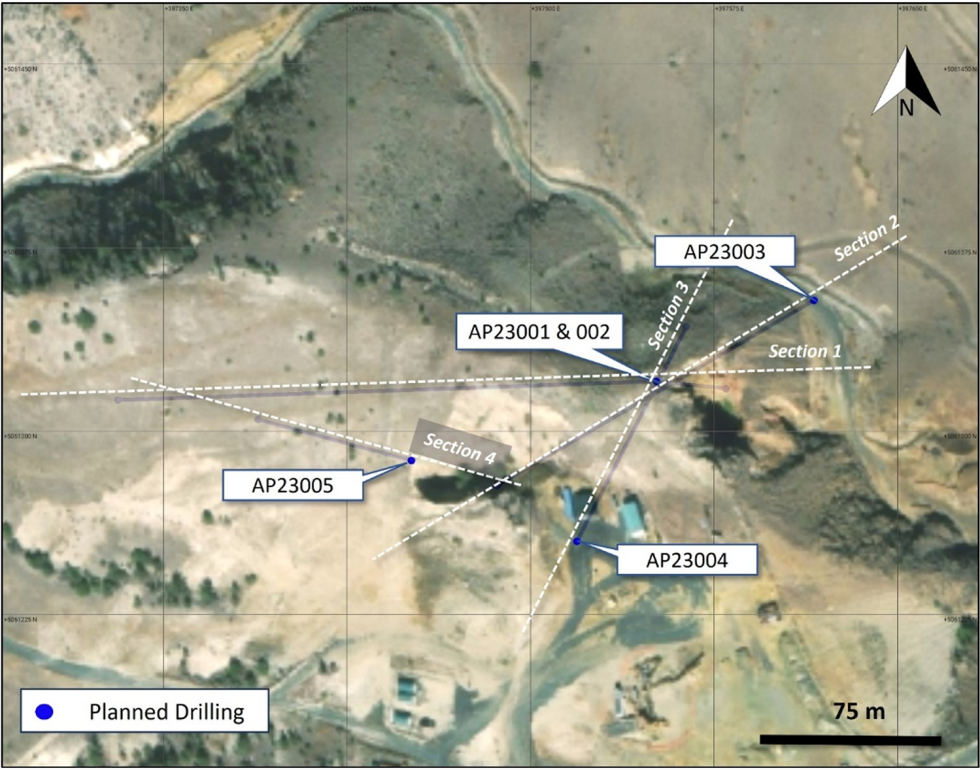American Pacific Mining Corp. (American Pacific or the Company) has announced that a diamond drilling campaign consisting of five (5) holes is scheduled to commence in the early part of the fourth quarter of 2023 at the Madison Copper-Gold Project (Madison or the Project.) situated in Madison County, Montana.
 American Pacific 2023 Diamond Drill Program. Image Credit: American Pacific Mining Corp.
American Pacific 2023 Diamond Drill Program. Image Credit: American Pacific Mining Corp.
The upcoming drill program is strategically designed to enhance the understanding of the near-surface, high-grade copper and gold mineralization and provide a foundation for deeper exploration in areas with limited historical drilling. In part, this program for 2023 will build upon the results of the previous partner-funded campaign, which notably included an intersection revealing 14.44 grams per ton (g/t) of gold (Au) over a length of 6.53 meters (m).
To accomplish multiple goals and test several such targets with each hole, drill holes have been placed strategically. Testing shallow gap areas, tightening drill spacing at moderate depth within the skarn to support future mineral resource estimation, and extending below known mineralization to provide useful information for deeper exploration in subsequent campaigns are the three main goals of the program.
We are excited to begin drilling at Madison and view this drilling campaign as an opportunity to make an already strongly mineralized system more robust while collecting valuable information in untested areas. The ultimate prize at Madison is the potential for a deep-rooted porphyry deposit, but we believe the shallow high-grade skarn mineralization will be an important contributor during the early years of any future mining scenario at Madison and believe it can expand significantly with further exploration work.
Warwick Smith, CEO, American Pacific Mining Corp.
Kennecott Exploration Company (KEX), a division of the Rio Tinto Group, has invested approximately US$6.8 million in the Madison Copper-Gold Project. They have the opportunity to earn up to a 70% stake in the Project by committing to spend US$30 million by 2030.
The focused Q4/2023 five-hole program (3,700 feet/1,130 m) will not include multiple planned deeper drill holes, which are part of the 2024 drilling strategy aimed at exploring the potential for porphyry mineralization at greater depths.
American Pacific will take the lead in executing the 2023 exploration drill campaign, with the support of KEX. The permitting process for the drill program is currently underway, and fieldwork will commence once all necessary permits have been granted.
Technical Summary
Different types of mineralization can be found all over the Property. Oxidized jasperoids, classic high-iron skarn, massive sulfides, and gold- and silver-rich quartz veining with typical high-level signatures and textures are examples of stronger mineralization. In the nearby granodiorite intrusive rock, endoskarns contain lower-grade gold mineralization.
All of these mineralization suites are thought to be connected to a number of igneous intrusion episodes that occurred from the late Cretaceous to the early Tertiary. The rocks that are hosting the mineralization determine the types and tenors of mineralization. The dolomitic rock of the Devonian Jefferson Formation typically contains high-level jasperoid mineralization.
Within the extremely reactive limestone and shale units of the greater Madison Group of Mississippian age, the skarn mineralization, including the massive sulfide, can be both gold- or copper-rich. Older Precambrian metasediments tend to contain the quartz vein mineralization. There is currently a lack of knowledge regarding the genesis and nature of quartz vein mineralization, as well as adequate testing.